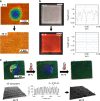Liquid crystal-based structural color actuators
- PMID: 35931672
- PMCID: PMC9356073
- DOI: 10.1038/s41377-022-00937-y
Liquid crystal-based structural color actuators
Abstract
Animals can modify their body shape and/or color for protection, camouflage and communication. This adaptability has inspired fabrication of actuators with structural color changes to endow soft robots with additional functionalities. Using liquid crystal-based materials for actuators with structural color changes is a promising approach. In this review, we discuss the current state of liquid crystal-based actuators with structural color changes and the potential applications of these structural color actuators in soft robotic devices.
© 2022. The Author(s).
Conflict of interest statement
The authors declare no competing interests.
Figures

















References
-
- Ma CX, et al. Bioinspired anisotropic hydrogel actuators with on–off switchable and color-tunable fluorescence behaviors. Adv. Funct. Mater. 2018;28:1704568. doi: 10.1002/adfm.201704568. - DOI
Publication types
LinkOut - more resources
Full Text Sources

